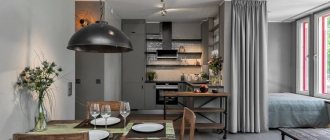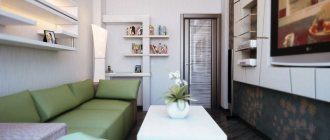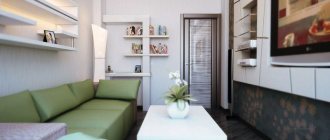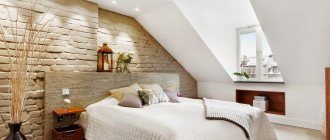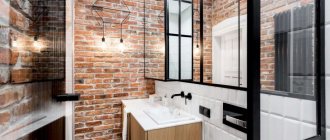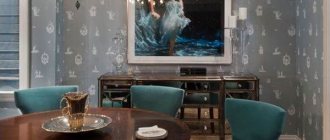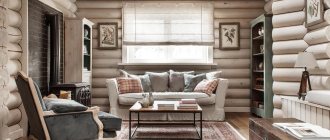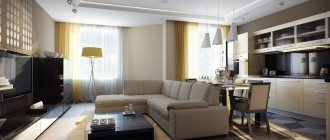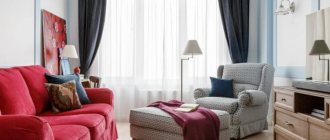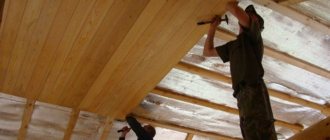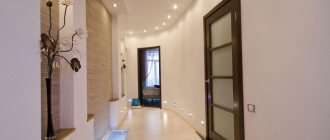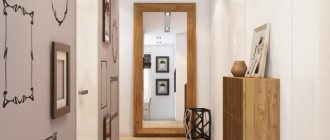The classicism of the English style for decorating country houses attracts both designers and ordinary people with its functionality, rigor and ability to well demonstrate the taste and character of its guests. Photos of English-style houses demonstrate the external roughness of unlined facades with low window openings and a bright red tiled roof.
The distinctive elements of the exterior of English apartments are:
- wall surfaces made of natural stone elements or bricks;
- lack of carved parts;
- asymmetry in the location of the exterior composition;
- presence of columns;
- narrow color palette;
- gable roof;
- The area near the house is planted with a garden and flowers.
Characteristic features of the English style
Such a house involves the use of red brick. It provides excellent sound insulation, is highly resistant to temperature changes, and has a long service life.
Usually this is a two-story building, sometimes with an attic, but there are also one-story houses in the English style.
Restraint, elegance, conservatism and rigor are the distinctive features of this architectural style.
Victorian 1800-1900
At this time, construction in England was not regulated by the state, as, for example, in France, so young English architects willingly practiced on private houses. Lots of practice led to free composition. The architects paid attention to the internal comfort of the house and the variety of social roles of the residents. Less attention was paid to the external attractiveness of the house, Palladian and generally Italian order canons began to be supplanted in favor of a convenient layout.
The Industrial Revolution and the mass production of decorative elements made it possible to decorate even relatively poor properties. Hence the general decorativeness of the facades. The most striking style of the Victorian era is the Queen Anne style.
Victorian style features
- Steep roof
- Complex asymmetrical shape
- Gable (pediment) facing the main facade
- Veranda framing one or two sides of the house
- Turret (round or square)
- The walls are decorated with stone, half-timbered or siding)
- Ornamental patterns
- Bay windows
- Decorative consoles
View examples of Victorian houses in our elevation database.
If you know these three English styles, consider that you will recognize all the classic English architecture. Just to broaden our cultural horizons, let's talk about the Palladian style.
Exterior of a brick house in English style
In the standard version, the entrance is located in the center of the building near tall columns.
The porch is almost always missing. However, awnings are often installed over the entrance and windows. They are usually as sharp as the roof.
The floor is located at ground level without artificial rise in the form of steps.
The facade is traditionally strict, allowing decoration only in exceptional cases. It is not painted or veneered.
The windows on the first floor are low. They are usually rectangular and quite large. Two- or three-leaf. In the classic version, the bottom of the frame rises up.
On the second floor the windows are also rectangular, in rare cases they are given an arched shape. They are placed evenly along the entire length of the wall.
The roof has a complex shape with numerous bevels. Its slopes protrude much further than in ordinary houses, which allows you to protect the house from excess dampness when it rains.
Traditionally, the roof is covered with tiles, usually red. Sometimes reed or straw is used instead.
Utility rooms are usually located under the roof.
Georgian architecture
Georgian style in architecture
Its features:
- symmetrical rectangular layout;
- high base;
- brick walls with discreet decor;
- identical, synchronously located windows;
- entrance with portico and decorative canopy;
- front door with panels and half-columns;
- mid-pitched roof with minimal overhang.
The 4th century, when the German Welf family took over the British crown, went down in history as the Georgian era. It was named so because the first four monarchs were Georges.
New tastes brought by kings, new technologies generated by the Industrial Revolution, and ideas and impressions coming from the colonies created a special type of architecture - Georgian.
He adopted many more ancient techniques than the Tudor style. Strict and stately proportions, proportionate arrangement of windows, cornices and moldings, as well as the rejection of the pomp inherent in Baroque, made it equally in demand both in the city and in country estates.
The culmination of Georgian architecture is considered to be the reign of George IV, who was regent. English house-building, having come under the beneficial influence of French architecture, became more refined and refined. The windows grew tall, the balconies were decorated in the ancient Greek and Roman style, the front door finally became an important architectural “persona” (it was decorated with pilasters, glass inserts, platbands, stucco coats of arms), a high porch with twisted consoles, and terraces with graceful balusters came into fashion. … It is not for nothing that this historical milestone deserves a separate name - the Regency Georgian style.
English style in the interior of a country house
The main room of such a house was the living room. Traditionally, it connects to the hall and adjoins the kitchen and dining room.
Despite the severity of the style, this room is designed to add comfort and coziness. It would be ideal to place large sofas and armchairs upholstered in leather or dark fabric.
Cabinets and tables are also kept in a dark style. Wood, bronze, dark silver are perfect.
House 140 sq. m.: finished projects, tips on choosing the design and decoration of a home (125 photos)House 9 by 11: ready-made projects and optimal solutions for placing rooms. 130 photos of interior and exterior design ideas
- Blue curtains: review of popular shades, combination options, new designs
The use of plastic or other artificial materials is not permitted. Wood is used to decorate the premises; walls and floors are decorated with it.
The ceiling throughout the house should be white. It is possible to use stucco or wooden beams. An excellent solution for the living room would be to place a fireplace.
It is also better to make the fireplace lining from natural materials - marble or wood. You can use tiles.
On the ground floor there can be an office and a library.
On the second floor there are living rooms. Usually there are three. The decoration uses plaster or wallpaper.
The traditional color of the second floor, beloved by the British, ranges from dark red to burgundy. It goes well with dark finishes on walls, stairs and doors.
A photo of a house in the English style shows all the characteristic features of this style.This style will be an excellent solution for a country building. Despite its strict and classic appearance, it can become a warm and cozy haven for the whole family.
Composition of project documentation
has been developing ready-made solutions for 15 years. Each finished project contains a complete package of documentation necessary for construction.
- Detailed description of all structures: foundation, walls, ceilings.
- Floor plans with a breakdown for each room: area, purpose.
- Specification of building materials, options for their replacement are indicated.
The project includes a set of working drawings: sections, masonry plans, floor explications, and a diagram for filling window openings. Some standard solutions include engineering communications projects. In most cases, water supply and electrification systems are developed individually. For example, when a customer requires a house with a second light (No. 35-12, 375 m2). Additionally, an architectural passport of the object is prepared.
Photos of English style houses
Help the project, share with friends

1+
Tudor houses
The small and somewhat fabulous houses that existed in the Tudor era received their own style direction, as they have an unsurpassed appearance, which has no analogues. In fact, the buildings had a rough and brutal appearance, and they were distinguished by the following features:
- The masonry of the house is made of red brick.
- Large chimney pipe (in most cases it was located closer to the facade).
- Small dormers.
- Lack of any symmetry.
- High gables, which also lack symmetry.
- The roof structure has uneven edges and steep slopes (in some cases, imitation straw was made).
- The entrance to the house is designed in the form of an arch, lined with large stones.
The whole point of the facade of a private house in the Tudor style is the lack of decoration, since it is made of solid brickwork.
A holiday for every day
This room has the style of modern England - with caricatures, vintage accessories, large bright windows, rich colors and a charming fireplace. As with many homes, designer and homeowner Harriett Anstruther took very light walls and simple wood floors and transformed the space into a “witty and unexpected solution,” in her own words. Well, we agree with her on this.
Bright colors of London
This small, light-filled apartment is a fresh embodiment of British tradition. A vintage fireplace, walls decorated with photographs and drawings, a crystal chandelier and a velvet sofa are echoes of the Victorian era. A little country: armchairs from grandma’s attic and blue wooden panels neatly zone the space. Bright yellow chairs create a festive atmosphere and give the delicate room a spirit of rebellion.
